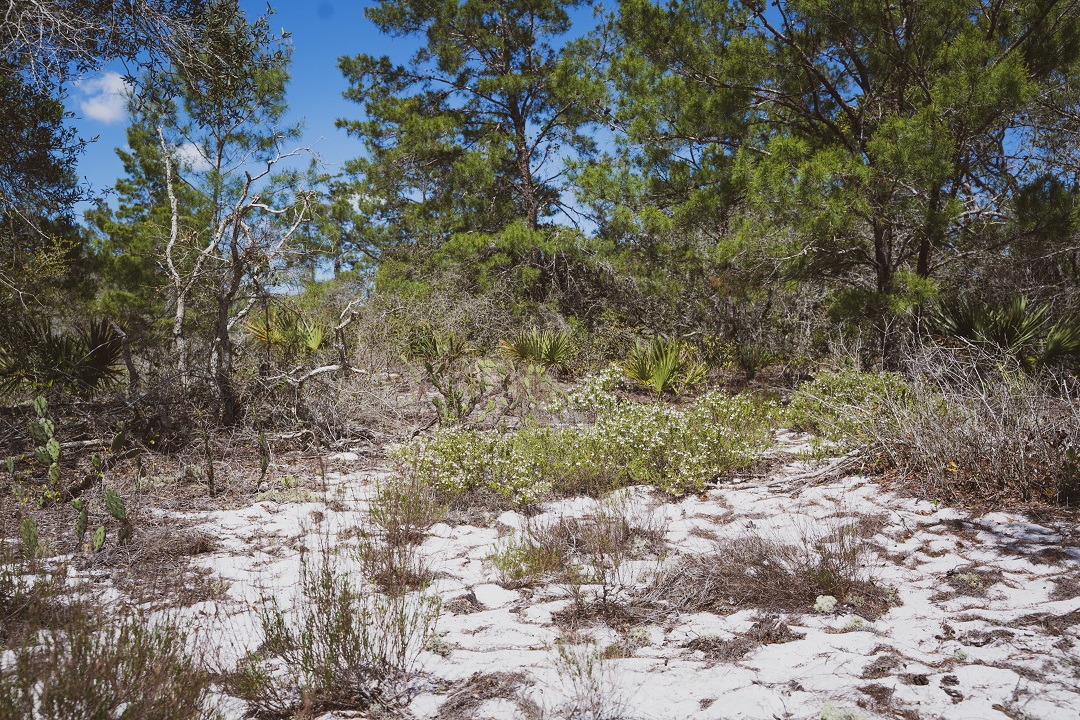
 This blog is part of this year’s Roots: Power of the Unseen theme, which celebrates the complex world beneath our feet and seeks to inspire a new appreciation for the unnoticed, yet vital parts of our ecosystem.
This blog is part of this year’s Roots: Power of the Unseen theme, which celebrates the complex world beneath our feet and seeks to inspire a new appreciation for the unnoticed, yet vital parts of our ecosystem.
What’s the first thing that comes to mind when you hear “wild Florida habitats?” You probably think of the Everglades, the swampy, dense, marshes that people call “old Florida.” Or you may think of our brackish waterways where paddlers can see manatees, gators, fish, and other wildlife. But what if we told you a desert was one of those wild Florida habitats? That’s right. Florida has desert habitats. We call them scrubs.
If you’ve spent any time around Southwest Florida, you’ve probably been to a scrub habitat, even if you didn’t know it. The scrub is located along Florida’s coastlines and inland sand ridges. Look between the beachhead and the swampy “old Florida” regions, and you will find this dry and sandy environment. But you might want to explore these regions soon. Sadly, scrubland is quickly disappearing.
Once ignored, coastal scrubs became prime real estate for oceanside development because their high elevation and dry conditions are perfect for building hotels, shops, and seaside restaurants. However, these attributes have caused the scrub to be one of the fastest-shrinking habitats in Florida, making it endangered. Only within the last few decades have scientists realized that these habitats are home to unique species of plants and animals, some of which live in no other ecosystems.
If scientists overlooked the scrub’s importance, of course the general public did as well. Eric Foht, Director of Natural Resources, shares, “Most people in Naples have explored the beautiful beaches — but most people have not explored an ancient beach, our uplands and scrub. These small sand ridges run parallel to our current coastline and are the ancient sand dunes and beaches from when sea levels were fluctuating in height. The sand that you will find here is nearly pure quartz.”

Scrub plants are specifically adapted to their desert-like habitat. Plants found in the scrub can’t grow in Florida’s wetter environments, like swamps, marshes, or the Everglades. The quartz sand is low in nutrients and does not offer stability for many root systems. This makes a tough sell for even the hardiest of plants. Thankfully, some plants do survive in this harsh environment.
They include:

Saw palmetto (Serenoa repens)
Saw palmetto is a hardy and slow-growing palm tree that snakes along the ground. By growing horizontally, it can send roots out of its trunk to hold it in place and cover more ground for nutrient absorption.

Scrub pine (Pinus clausa)
One of the few trees that can survive in the scrub, this pine is adapted to grow in sandy, nutrient-poor soil and is usually shorter in comparison to the common towering slash pine (Pinus ellitottii var. densa). It has a unique strategy for dealing with the wildfires that frequently ignite in the scrub. The trees drop pine cones that lay on the ground and remain dormant for years. Only when wildfire visits do the cones open and reseed the burnt ground. Reseeding by fire is a common adaptation among scrub plants.
If you would like to visit a scrub habitat yourself, consider taking a walk out into our Smith Uplands Preserve. A sandy pathway connects at two junctions along the north side of the paved lake trail. Our Preserve helps conserve a small slice of Florida scrubland, and we are dedicated to protecting it so that plants, animals, and humans can enjoy it.
About the Authors
 Adrienne Lewis is an Educator I at Naples Botanical Garden.
Adrienne Lewis is an Educator I at Naples Botanical Garden.
 Kyle Possai is an Educator II at Naples Botanical Garden. When not at the Garden, he enjoys making music through guitar and piano.
Kyle Possai is an Educator II at Naples Botanical Garden. When not at the Garden, he enjoys making music through guitar and piano.

